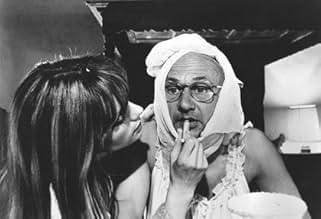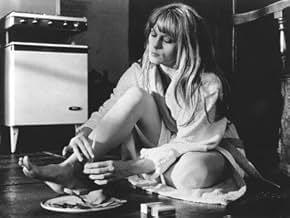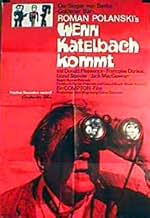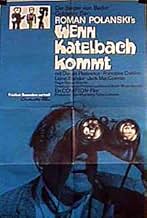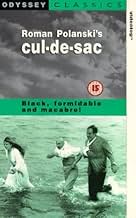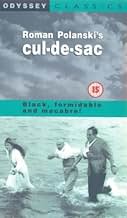Cul-de-sac
- 1966
- Tous publics
- 1h 52min
NOTE IMDb
7,0/10
15 k
MA NOTE
Deux gangsters blessés et en fuite trouvent refuge dans le château isolé d'un homme faible et de sa femme, en quête d'aide ; toutefois, sous la menace d'une arme à feu, les apparences sont t... Tout lireDeux gangsters blessés et en fuite trouvent refuge dans le château isolé d'un homme faible et de sa femme, en quête d'aide ; toutefois, sous la menace d'une arme à feu, les apparences sont trompeuses.Deux gangsters blessés et en fuite trouvent refuge dans le château isolé d'un homme faible et de sa femme, en quête d'aide ; toutefois, sous la menace d'une arme à feu, les apparences sont trompeuses.
- Réalisation
- Scénario
- Casting principal
- Nomination aux 1 BAFTA Award
- 1 victoire et 1 nomination au total
Jacqueline Bisset
- Jacqueline
- (as Jackie Bisset)
Avis à la une
As 'Cul-de-sac' was Polanski's first movie after his brilliant psychological thriller 'Repulsion' it can't help but be a slight disappointment. Even so, I thought it was an interesting movie and I found it to be much more enjoyable than his next one the totally unfunny spoof 'The Fearless Vampire Killers'. 'Cul-de-sac' is quite difficult to catergorise. In some ways it reminded me of Pinter's 'The Birthday Party' (filmed much later than this but originally staged in the late 1950s), in others of Jack Hill's cult favourite 'Spider Baby' (made earlier but not really released until afterwards), and you could almost see it as prefiguring 'Performance' (old school gangsters meet the new world of the swinging 1960s). But really it quite an odd and unique black comedy. It may not be 100% successful, and it does have a few dull spots, but overall it's worth tracking down if you want to see something different. The main reason it succeeds for me is the unusual location of Lindisfarne, England (which I have visited), and the performances of Donald Pleasence, Francoise Dorleac and Lionel Stander. Pleasence was one of Britain's most underrated character actors, the beautiful and doomed Dorleac had appeared alongside Jean-Paul Belmondo in the entertaining thriller 'That Man From Rio', and Standish, who later appeared in movies by Leone and Spielberg, is best remembered as Max, the craggy manservant on the popular 1980s TV show 'Hart To Hart'. All three are excellent in this movie, and their interaction make it fascinating viewing. The supporting cast also includes Jack MacGowran ('The Exorcist') and an early appearance by 1970s sex symbol Jacqueline Bisset. 'Cul-de-sac' is without a doubt Polanski's most underrated movie, and fans of the unusual and the off beat will enjoy it very much. A DVD with a commentary from Polanski would would be wonderful. Any chance?
Finally had the opportunity to watch this film. I love Roman Polanski's work. The first two films of The Apartment trilogy are phenomenal. Even his recent stuff is so good (I'm talking especially about Carnage). This is a film he worked on in between Repulsion and Rosemary's Baby and going in I had no idea what it was about. After watching I don't think its among Polanski's best but still enjoyable and pretty damn frenetic like most of his work at the time.
The film follows a gangster and his dying partner who take refuge in a castle out in an island. On this island lives quite a neurotic man and his girlfriend and they kind of have to give into the whims of their captor. In a way push comes to shove and things get hectic between the trio and others coming onto the island. Its hard to explain this film fully giving it justice without spoiling. While the film has flaws and isn't as memorable as some of his others that came out at the same time.
It doesn't really tap into fear and paranoia like Rosemary's Baby and Repulsion; its another thing thematically. I think the comedic aspect of the film kind of hurts it from being one of Polanski's finer works. I think Polanski knows how to tap into fear, anxiety, paranoia and this film is pretty void of that. It's nice seeing Donald Pleasance in something so different prior to his Halloween days.
Overall, its worth a watch for people who really like Polanski's work although he is capable of much better. Its still an alluring experience as with most of his work. It doesn't quite feel as claustrophobic a film as it could be (with the title and his other work). I might go on a bit of a Polanski binge and watch a bunch of other stuff I haven't seen. Or, revisit some of his best which should be fun.
7/10
The film follows a gangster and his dying partner who take refuge in a castle out in an island. On this island lives quite a neurotic man and his girlfriend and they kind of have to give into the whims of their captor. In a way push comes to shove and things get hectic between the trio and others coming onto the island. Its hard to explain this film fully giving it justice without spoiling. While the film has flaws and isn't as memorable as some of his others that came out at the same time.
It doesn't really tap into fear and paranoia like Rosemary's Baby and Repulsion; its another thing thematically. I think the comedic aspect of the film kind of hurts it from being one of Polanski's finer works. I think Polanski knows how to tap into fear, anxiety, paranoia and this film is pretty void of that. It's nice seeing Donald Pleasance in something so different prior to his Halloween days.
Overall, its worth a watch for people who really like Polanski's work although he is capable of much better. Its still an alluring experience as with most of his work. It doesn't quite feel as claustrophobic a film as it could be (with the title and his other work). I might go on a bit of a Polanski binge and watch a bunch of other stuff I haven't seen. Or, revisit some of his best which should be fun.
7/10
A diminutive artist (Donald Pleasence) lives with his much-younger French wife (Françoise Dorléac) in a castle on a tidal island in northern England. When a gruff gangster (Lionel Stander) shows up on their doorstep havoc ensues. Iain Quarrier, William Franklyn and a young Jacqueline Bisset show up for peripheral parts.
"Cul-de-Sac" (1966) is one of Roman Polanski's early experiments, a freestyle B&W psychological crime dramedy that takes elements of "The Damned" (1963), "Touch of Evil" (1958) and "A Streetcar Named Desire" (1951) and mixes them with black humor and the theme of the later "Straw Dogs" (1971). Jack Nicholson cited it as his favorite film, which makes sense when you consider Nicholson's "The Shooting" (1966). In tone, it's the precursor to Altman flicks like "The Long Goodbye" (1973).
There's such an improvisational feel that one wonders what the point is: French girls are neurotic and promiscuous? British artists are wussies? Those who live by the gun will die by the gun? No matter how much a person tries to escape the world to focus on fulfilling his/her art (whatever that might be), the corruption of the world will come knocking on your door and might even share your bed? That even a finely cultured man will resort to his primordial nature if backed into a corner?
The film obviously has its partisans, who deem it a masterpiece. There are some interesting technical things going on, like the 7.5 minute scene on the beach, which was one of the longest continuous sequences in cinema up to that point. But the characters are oddball and unlikable while the story is meandering and dramatically dull. Yet the locations, the cast and the themes are to die for, not to mention the eccentricities.
The film runs 1 hour, 52 minutes, and was shot at Holy Island of Lindisfarne, off the coast of northeastern England.
GRADE B-/C+
"Cul-de-Sac" (1966) is one of Roman Polanski's early experiments, a freestyle B&W psychological crime dramedy that takes elements of "The Damned" (1963), "Touch of Evil" (1958) and "A Streetcar Named Desire" (1951) and mixes them with black humor and the theme of the later "Straw Dogs" (1971). Jack Nicholson cited it as his favorite film, which makes sense when you consider Nicholson's "The Shooting" (1966). In tone, it's the precursor to Altman flicks like "The Long Goodbye" (1973).
There's such an improvisational feel that one wonders what the point is: French girls are neurotic and promiscuous? British artists are wussies? Those who live by the gun will die by the gun? No matter how much a person tries to escape the world to focus on fulfilling his/her art (whatever that might be), the corruption of the world will come knocking on your door and might even share your bed? That even a finely cultured man will resort to his primordial nature if backed into a corner?
The film obviously has its partisans, who deem it a masterpiece. There are some interesting technical things going on, like the 7.5 minute scene on the beach, which was one of the longest continuous sequences in cinema up to that point. But the characters are oddball and unlikable while the story is meandering and dramatically dull. Yet the locations, the cast and the themes are to die for, not to mention the eccentricities.
The film runs 1 hour, 52 minutes, and was shot at Holy Island of Lindisfarne, off the coast of northeastern England.
GRADE B-/C+
CUL-DE-SAC is a psychological comic thriller as an unusual set of surreal circumstances in a realistic landscape. The characters are trapped in a confusing context, which is made up of a mafia, art, promiscuity and perversions. The story is peppered with all sorts of antics, but it is not unpleasant. The plots are inconclusive, but its are enriched with a huge dose of black humor.
A neurotic and effeminate middle-aged Englishman named George lives with his promiscuous young French wife Teresa in a dark castle on a hilltop. Two gangsters, after the unexpected upward tide, invade their messy home and hold them as hostage. Teresa is mad at her timid husband, who does not take any action on the bandits. Gangsters are starting to behave a bit eccentric, while waiting for help from his boss. Uninvited guests come to a visit. Simply, someone has to "boil over"...
Mr. Polanski, in this film, covers topics such as the alienation and a latent madness, which are closely related to a sexual activity. He has managed to replace an emotional void in this film with a combination of black humor, crime and perversion. The characterization is not bad.
Donald Pleasence as George is a kinky and fun husband who has his grotesque moments in this film. He is a man who feels comfortable in a transparent nightgown but he, with a huge dose of disgust, takes a gun in his hand. That is a phenomenal paradox of the situation in the world. His cowardice is ambiguous, because, despite everything, he wants to return a harmonious relation in his home. Lionel Stander as Dickey, through his gangster attitude, distinctive voice and eccentric behavior enjoys the general madness. Françoise Dorléac as Teresa is a beautiful, attractive and nude factor of confusion between George and Dickey.
Mr. Polanski has skillfully managed to balance all segments in this film, but this story still reminds me to a sexy morbid joke.
A neurotic and effeminate middle-aged Englishman named George lives with his promiscuous young French wife Teresa in a dark castle on a hilltop. Two gangsters, after the unexpected upward tide, invade their messy home and hold them as hostage. Teresa is mad at her timid husband, who does not take any action on the bandits. Gangsters are starting to behave a bit eccentric, while waiting for help from his boss. Uninvited guests come to a visit. Simply, someone has to "boil over"...
Mr. Polanski, in this film, covers topics such as the alienation and a latent madness, which are closely related to a sexual activity. He has managed to replace an emotional void in this film with a combination of black humor, crime and perversion. The characterization is not bad.
Donald Pleasence as George is a kinky and fun husband who has his grotesque moments in this film. He is a man who feels comfortable in a transparent nightgown but he, with a huge dose of disgust, takes a gun in his hand. That is a phenomenal paradox of the situation in the world. His cowardice is ambiguous, because, despite everything, he wants to return a harmonious relation in his home. Lionel Stander as Dickey, through his gangster attitude, distinctive voice and eccentric behavior enjoys the general madness. Françoise Dorléac as Teresa is a beautiful, attractive and nude factor of confusion between George and Dickey.
Mr. Polanski has skillfully managed to balance all segments in this film, but this story still reminds me to a sexy morbid joke.
A wounded criminal and his dying partner take up refuge at a beachfront villa, which (not surprisingly) makes the owners less than thrilled.
I watched this as part of my quest to see all of Polanski's films in order. After two psychological films, he has switched to comedy... and I am not entirely sure I get it. Visually, this film is quite stunning and it has some good camera work (including one of the longest continuous sequences in cinematic history at the time of release at 7 minutes and 28 seconds).
Jack Nicholson claimed in an interview in 2007 that this is his favorite film. Not sure what to make of that. I loved Donald Pleasance as the cross-dressing wimp, but beyond that, I just do not think I really got it... the humor was not so strong and the darkness was not all that dark.
I watched this as part of my quest to see all of Polanski's films in order. After two psychological films, he has switched to comedy... and I am not entirely sure I get it. Visually, this film is quite stunning and it has some good camera work (including one of the longest continuous sequences in cinematic history at the time of release at 7 minutes and 28 seconds).
Jack Nicholson claimed in an interview in 2007 that this is his favorite film. Not sure what to make of that. I loved Donald Pleasance as the cross-dressing wimp, but beyond that, I just do not think I really got it... the humor was not so strong and the darkness was not all that dark.
Le saviez-vous
- AnecdotesRoman Polanski shot 16 takes of the scene in which Lionel Stander drinks a pint of milk.
- GaffesWhen Dickie is pushing the car, the shadow of the camera and the cameraman can be seen on him.
- Versions alternativesThe VHS version released in Brazil by Globo Vídeo has exactly 100 minutes.
- ConnexionsFeatured in Le ciné-club de Radio-Canada: Film présenté: Cul-de-sac (1975)
Meilleurs choix
Connectez-vous pour évaluer et suivre la liste de favoris afin de recevoir des recommandations personnalisées
Détails
- Date de sortie
- Pays d’origine
- Site officiel
- Langue
- Aussi connu sous le nom de
- Ćorsokak
- Lieux de tournage
- Sociétés de production
- Voir plus de crédits d'entreprise sur IMDbPro
Box-office
- Montant brut mondial
- 1 500 $US
- Durée
- 1h 52min(112 min)
- Couleur
- Rapport de forme
- 1.66 : 1
Contribuer à cette page
Suggérer une modification ou ajouter du contenu manquant


